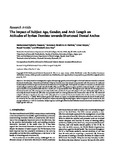The Impact of Subject Age, Gender, and Arch Length on Attitudes of Syrian Dentists towards Shortened Dental Arches
| dc.contributor.author | Nassani, MZ | |
| dc.contributor.author | Al-Nahhal, TI | |
| dc.contributor.author | Kujan, O | |
| dc.contributor.author | Tarakji, B | |
| dc.contributor.author | Kay, EJ | |
| dc.date.accessioned | 2015-12-14T10:59:11Z | |
| dc.date.available | 2015-12-14T10:59:11Z | |
| dc.date.issued | 2015 | |
| dc.identifier.issn | 1687-8728 | |
| dc.identifier.issn | 1687-8736 | |
| dc.identifier.other | ARTN 643176 | |
| dc.identifier.uri | http://hdl.handle.net/10026.1/3948 | |
| dc.description.abstract |
<jats:p><jats:italic>Objective</jats:italic>. This study aimed to investigate the impact of subject age, gender, and arch length on dentists’ attitudes towards unrestored shortened dental arches.<jats:italic>Materials and Methods</jats:italic>. 93 Syrian dentists were interviewed and presented with 24 scenarios for male and female subjects of different ages and shortened dental arches of varying length. Participants were asked to indicate on a standardized visual analogue scale how they would value the health of the mouth if the posterior space was left unrestored.<jats:italic>Results</jats:italic>. A value of 0.0 represented the worst possible health state for a mouth and 1.0 represented the best. The highest mean value (0.73) was assigned to a shortened dental arch with missing second molar teeth in the mouth of a 70-year-old subject. A 35-year-old female subject with an extremely shortened dental arch (all molar and premolar teeth are missing) attracted the lowest mean value (0.26). The statistical analysis indicated a significant decrease in the value placed on unrestored shortened dental arches as the number of remaining teeth decreased (<mml:math xmlns:mml="http://www.w3.org/1998/Math/MathML" id="M1"><mml:mi>p</mml:mi><mml:mo><</mml:mo><mml:mn>0.008</mml:mn></mml:math>). While subject gender had almost no impact on dentists’ attitudes towards shortened dental arches, the scenarios for the older shortened dental arch subjects attracted significantly higher values compared to the scenarios for the younger subjects (<mml:math xmlns:mml="http://www.w3.org/1998/Math/MathML" id="M2"><mml:mi>p</mml:mi><mml:mo><</mml:mo><mml:mn>0.017</mml:mn></mml:math>).<jats:italic>Conclusion</jats:italic>. Subject age and arch length affect dentists’ attitudes towards shortened dental arches, but subject gender does not.</jats:p> | |
| dc.format.extent | 1-7 | |
| dc.format.medium | Print-Electronic | |
| dc.language | en | |
| dc.language.iso | eng | |
| dc.publisher | Hindawi Limited | |
| dc.subject | 32 Biomedical and Clinical Sciences | |
| dc.subject | 3203 Dentistry | |
| dc.subject | Clinical Research | |
| dc.subject | Clinical Trials and Supportive Activities | |
| dc.subject | Dental/Oral and Craniofacial Disease | |
| dc.subject | Oral and gastrointestinal | |
| dc.title | The Impact of Subject Age, Gender, and Arch Length on Attitudes of Syrian Dentists towards Shortened Dental Arches | |
| dc.type | journal-article | |
| dc.type | Article | |
| plymouth.author-url | https://www.ncbi.nlm.nih.gov/pubmed/26265916 | |
| plymouth.volume | 2015 | |
| plymouth.publication-status | Published | |
| plymouth.journal | International Journal of Dentistry | |
| dc.identifier.doi | 10.1155/2015/643176 | |
| plymouth.organisational-group | /Plymouth | |
| plymouth.organisational-group | /Plymouth/Faculty of Health | |
| plymouth.organisational-group | /Plymouth/Research Groups | |
| plymouth.organisational-group | /Plymouth/Research Groups/Institute of Health and Community | |
| plymouth.organisational-group | /Plymouth/Research Groups/Institute of Translational and Stratified Medicine (ITSMED) | |
| plymouth.organisational-group | /Plymouth/Research Groups/Institute of Translational and Stratified Medicine (ITSMED)/CCT&PS | |
| plymouth.organisational-group | /Plymouth/Users by role | |
| dc.publisher.place | Egypt | |
| dcterms.dateAccepted | 2015-07-05 | |
| dc.identifier.eissn | 1687-8736 | |
| dc.rights.embargoperiod | Not known | |
| rioxxterms.versionofrecord | 10.1155/2015/643176 | |
| rioxxterms.licenseref.uri | http://www.rioxx.net/licenses/all-rights-reserved | |
| rioxxterms.licenseref.startdate | 2015 | |
| rioxxterms.type | Journal Article/Review |


